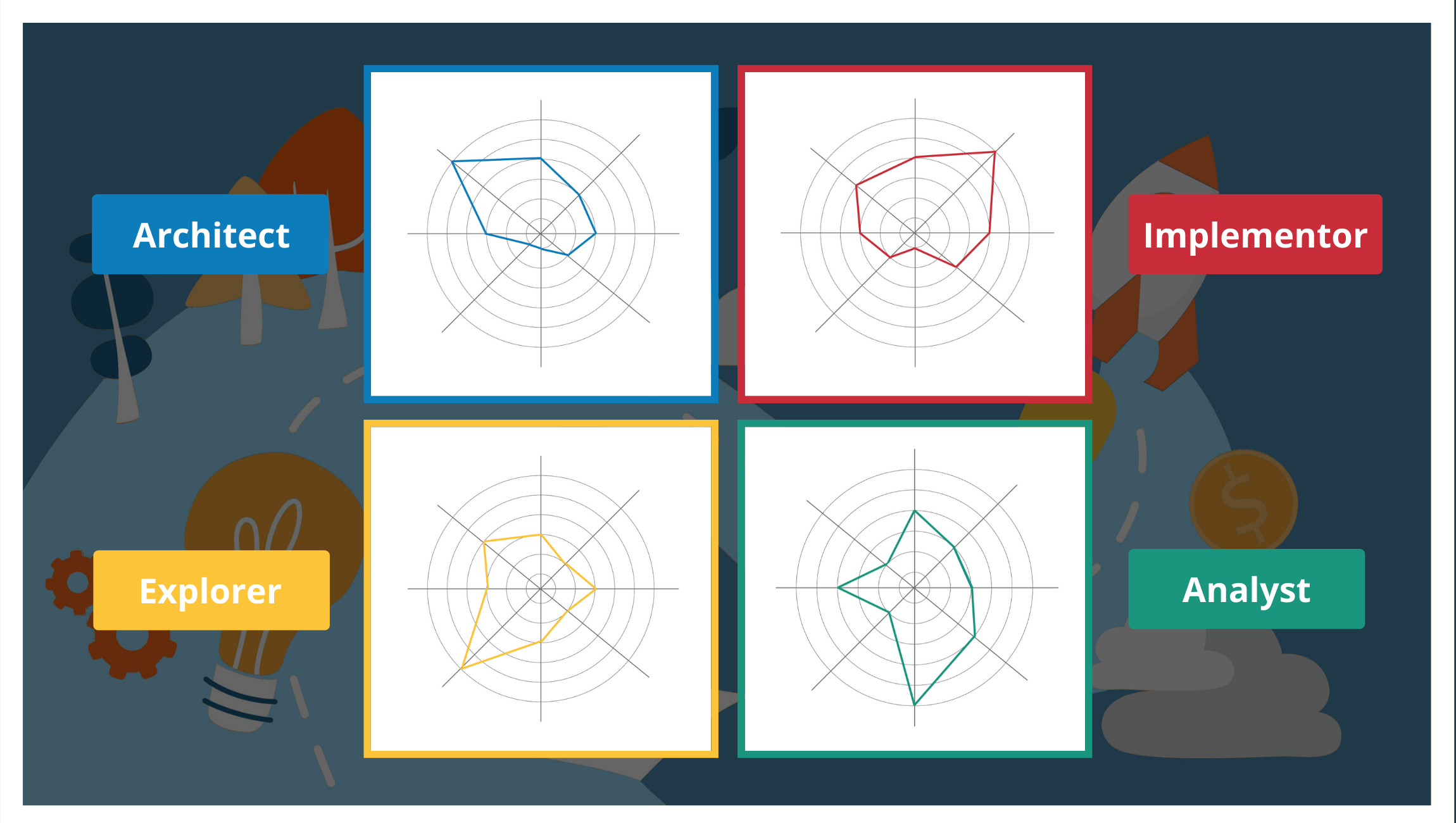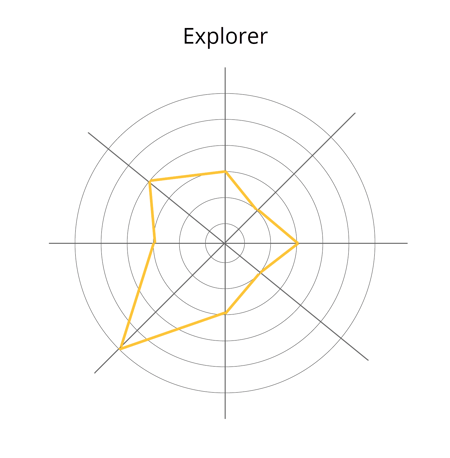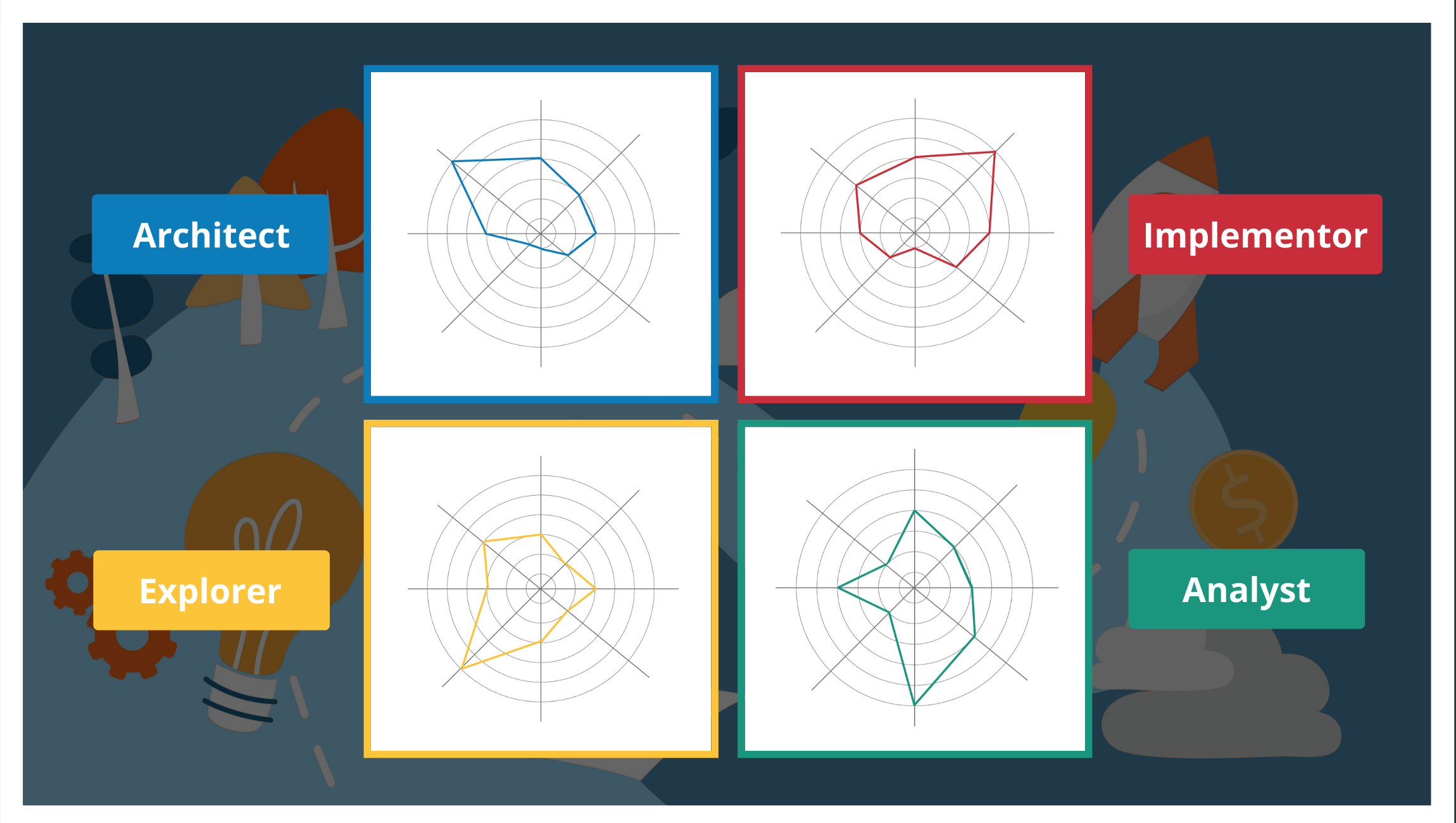
During the process of writing this book, as a series of articles written for a social media audience, we’ve been working on a series of projects in parallel (yes, I did that). During the process we’ve been ‘going meta’ and looking at the roles and responsibilities both ourselves and the rest of the team across many businesses ‘take on’ - and here is the result.
Within the territory of this Digital Cybernetic framework, we can consider there to be 4 primary roles: The Architect, The Implementer, The Analyst, and The Explorer.
Each of these roles is equally important, equally challenging, equally time consuming, and as much available within one person as across a team. In other words, YOU or someone else could be moving between each of these roles dependant upon the need of the situation - this is your own personal requisite variety. In other words, the more flexibly you can take on each of these roles yourself, the more complete your perspective will be of the task at hand.
The reality is, however, that you will specialise and favour one or two roles - unless of course your intent is to dominate the system as the ‘main controller’ which is so often the situation when you are building a business with a small team, and it’s your business.
Let’s take a look at the component parts of the roles before we look at each one in turn.
The components to the Digital Cybernetic roles
There are 4 polarities to consider...
.png?width=650&name=4%20roles%20(1).png)
Starting on the left hand side, and moving clockwise we have:
Big picture - Detail
Visual - Numeric
Process - Opportunity seeking
Repetitive Tasks - Creativity
Big picture - Detail
As you’d expect, this polarity determines the ‘view’ you have of a situation. Big picture is macro, and Detail is micro.
Think of this like ‘a slider’, moving in and out of a situation.
Visual - Numeric
Visual means that the preference for the display and explanation of information, including concepts, is to do it visually.
The alternative here is called Numeric - which is ‘about numbers’ but also about how things should ‘add up’.
Process - Opportunity seeking
Process enables things that already are connected to ‘work’ better, whereas Opportunity Seeking is often when a person is seeking ways to improve the situation, or attempting to discover something that has not yet been seen.
Repetitive Tasks - Creativity
You’ll need to perform Repetitive Tasks in order for a process to scale, but it is down to Creativity to find new ways of doing things. As such, creativity is the death of repetitive tasks, and vice versa.
Hopefully you’ll take away from this a feeling that each aspect tends to roll into the next - with the lines blurring on the boundaries of each. This is the intent as from the outset I want you to consider your own success as a Digital Cyberneticist to be down to how you move between all position, when needed.
Next we can look at each role in turn...
The Architect

As an Architect you love to hold a vision of how things could be, if only everything was better connected. This vision is what you enjoy getting down onto paper, and even though it can be a struggle sometimes to see all the elements, you have faith that following the process you will work it out.

The Implementer

As an Implementer you’d rather spend time organising everything than thinking about doing it. You have ‘quite enough’ to be going on with, and you don’t need any additional ideas to get in your way. Seeing as you love processes, you are also on the lookout how to speed everything up and make your life easier.

The Analyst

As an Analyst you enjoy taking a step back from having to give an opinion right away. You operate based on facts, and even though gut feel might be important to you, it’s the data you can access that will determine your opinion. And when you can’t find the data, you may still give your opinion but based on facts, and with any caveats you may feel are necessary.

The Explorer

As a digital Explorer, you probably LOVE picking through a Keyword Report, looking for hidden treasures; you spend your time hunting for the ‘next thing’ that will give you the edge. You are creative, and get a buzz from the potential of things - which inevitably means you sometimes act too quickly without knowing for sure whether something is ‘good’ or will work.

How to work toward combining the roles
As mentioned from the start, within Digital Cybernetics you’d have great benefit in developing strengths in each of these areas yourself - you can then employ that skill set dependant upon the circumstance.
It’s this ‘switching between’ that makes it a complex role for one person - but it is the reality for many operators within the digital space already. Putting it simply, you need to do it all yourself so it all gets done quickly.
If that’s the case, you’re the one who has the most flexibility within the system to do the Analysis, whilst Exploring new approaches and ideas, and to structure how you’ll Implement it all into an Architectural plan (or more).
You’re the one that doesn’t need anybody else to get a project moving - you can pull it together yourself. Of course, you may not want to do this forever as it can be lonely and isolating, but it will lend well to you knowing each role that the strengths play to. For instance, you will be able to hire people better, and maybe even hire better people, when you know what you expect of them as you’ve done an aspect of this job already. In fact, the way we work in Plus Your Business! is most often to do just that. Myself and Elisa know every job within the business as we’ve done them ourselves, before showing a team member what to do - often using process documentation, and quick screen capture videos to communicate any nuances.
You may well find that the left hand roles (Implementer and Analysis) are the easiest ones for other people to operate within, but this doesn’t mean they are any less valuable or ‘skilled’. It just means there is less creativity required, which often makes it easier to teach/learn.
It’s worth noting that even though an Analyst may have a more ‘numeric’ mindset, it doesn’t mean they are an accountant. This role is more to do with surfacing key information, and the connecting that information across multiple platforms so that some type of ‘meaning’ emerges. The Analyst, using a phrase from one of my favourite Professors Robert Kegan, helps us to be ‘meaning makers’ based on a hypothesis that’s been tested.
The role of steering
All along, as you take on a role, know that you’ll have in mind your ‘one goal’ for the system.
Without the goal, however, you’ll find it very hard to Organise/Optimise the elements of the system in a way that will help get you there most efficiently.
Remember: you steer your vehicle toward your goal
And every action you take within the role you take is to better serve this mechanism. The more people who are working together in this way, the smoother the ride should be. A Digital Cyberneticist is skilled at the helm, even when they are not the captain of the ship.
Whether you move your mind into that of an Architect, Implementer, Analyst or Explorer, you are still steering the ship with each and every piece of communication you make, adjusting course as you go.
Just make sure you are on the right vehicle for you.


During the process of writing this book, as a series of articles written for a social media audience, we’ve been working on a series of projects in parallel (yes, I did that). During the process we’ve been ‘going meta’ and looking at the roles and responsibilities both ourselves and the rest of the team across many businesses ‘take on’ - and here is the result.
Within the territory of this Digital Cybernetic framework, we can consider there to be 4 primary roles: The Architect, The Implementer, The Analyst, and The Explorer.
Each of these roles is equally important, equally challenging, equally time consuming, and as much available within one person as across a team. In other words, YOU or someone else could be moving between each of these roles dependant upon the need of the situation - this is your own personal requisite variety. In other words, the more flexibly you can take on each of these roles yourself, the more complete your perspective will be of the task at hand.
The reality is, however, that you will specialise and favour one or two roles - unless of course your intent is to dominate the system as the ‘main controller’ which is so often the situation when you are building a business with a small team, and it’s your business.
Let’s take a look at the component parts of the roles before we look at each one in turn.
The components to the Digital Cybernetic roles
There are 4 polarities to consider...
.png?width=650&name=4%20roles%20(1).png)
Starting on the left hand side, and moving clockwise we have:
Big picture - Detail
Visual - Numeric
Process - Opportunity seeking
Repetitive Tasks - Creativity
Big picture - Detail
As you’d expect, this polarity determines the ‘view’ you have of a situation. Big picture is macro, and Detail is micro.
Think of this like ‘a slider’, moving in and out of a situation.
Visual - Numeric
Visual means that the preference for the display and explanation of information, including concepts, is to do it visually.
The alternative here is called Numeric - which is ‘about numbers’ but also about how things should ‘add up’.
Process - Opportunity seeking
Process enables things that already are connected to ‘work’ better, whereas Opportunity Seeking is often when a person is seeking ways to improve the situation, or attempting to discover something that has not yet been seen.
Repetitive Tasks - Creativity
You’ll need to perform Repetitive Tasks in order for a process to scale, but it is down to Creativity to find new ways of doing things. As such, creativity is the death of repetitive tasks, and vice versa.
Hopefully you’ll take away from this a feeling that each aspect tends to roll into the next - with the lines blurring on the boundaries of each. This is the intent as from the outset I want you to consider your own success as a Digital Cyberneticist to be down to how you move between all position, when needed.
Next we can look at each role in turn...
The Architect

As an Architect you love to hold a vision of how things could be, if only everything was better connected. This vision is what you enjoy getting down onto paper, and even though it can be a struggle sometimes to see all the elements, you have faith that following the process you will work it out.

The Implementer

As an Implementer you’d rather spend time organising everything than thinking about doing it. You have ‘quite enough’ to be going on with, and you don’t need any additional ideas to get in your way. Seeing as you love processes, you are also on the lookout how to speed everything up and make your life easier.

The Analyst

As an Analyst you enjoy taking a step back from having to give an opinion right away. You operate based on facts, and even though gut feel might be important to you, it’s the data you can access that will determine your opinion. And when you can’t find the data, you may still give your opinion but based on facts, and with any caveats you may feel are necessary.

The Explorer

As a digital Explorer, you probably LOVE picking through a Keyword Report, looking for hidden treasures; you spend your time hunting for the ‘next thing’ that will give you the edge. You are creative, and get a buzz from the potential of things - which inevitably means you sometimes act too quickly without knowing for sure whether something is ‘good’ or will work.

How to work toward combining the roles
As mentioned from the start, within Digital Cybernetics you’d have great benefit in developing strengths in each of these areas yourself - you can then employ that skill set dependant upon the circumstance.
It’s this ‘switching between’ that makes it a complex role for one person - but it is the reality for many operators within the digital space already. Putting it simply, you need to do it all yourself so it all gets done quickly.
If that’s the case, you’re the one who has the most flexibility within the system to do the Analysis, whilst Exploring new approaches and ideas, and to structure how you’ll Implement it all into an Architectural plan (or more).
You’re the one that doesn’t need anybody else to get a project moving - you can pull it together yourself. Of course, you may not want to do this forever as it can be lonely and isolating, but it will lend well to you knowing each role that the strengths play to. For instance, you will be able to hire people better, and maybe even hire better people, when you know what you expect of them as you’ve done an aspect of this job already. In fact, the way we work in Plus Your Business! is most often to do just that. Myself and Elisa know every job within the business as we’ve done them ourselves, before showing a team member what to do - often using process documentation, and quick screen capture videos to communicate any nuances.
You may well find that the left hand roles (Implementer and Analysis) are the easiest ones for other people to operate within, but this doesn’t mean they are any less valuable or ‘skilled’. It just means there is less creativity required, which often makes it easier to teach/learn.
It’s worth noting that even though an Analyst may have a more ‘numeric’ mindset, it doesn’t mean they are an accountant. This role is more to do with surfacing key information, and the connecting that information across multiple platforms so that some type of ‘meaning’ emerges. The Analyst, using a phrase from one of my favourite Professors Robert Kegan, helps us to be ‘meaning makers’ based on a hypothesis that’s been tested.
The role of steering
All along, as you take on a role, know that you’ll have in mind your ‘one goal’ for the system.
Without the goal, however, you’ll find it very hard to Organise/Optimise the elements of the system in a way that will help get you there most efficiently.
Remember: you steer your vehicle toward your goal
And every action you take within the role you take is to better serve this mechanism. The more people who are working together in this way, the smoother the ride should be. A Digital Cyberneticist is skilled at the helm, even when they are not the captain of the ship.
Whether you move your mind into that of an Architect, Implementer, Analyst or Explorer, you are still steering the ship with each and every piece of communication you make, adjusting course as you go.
Just make sure you are on the right vehicle for you.


